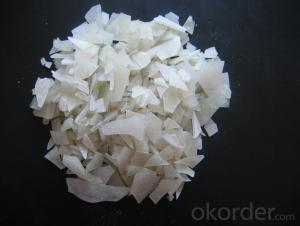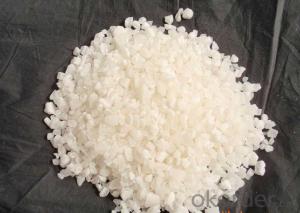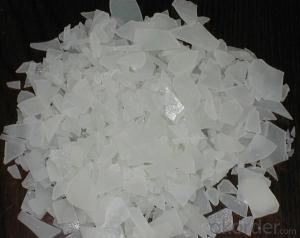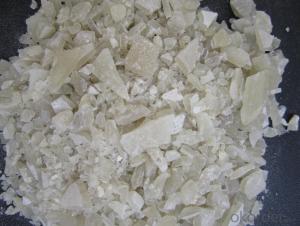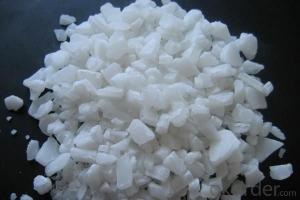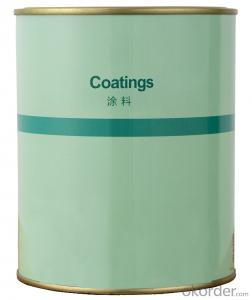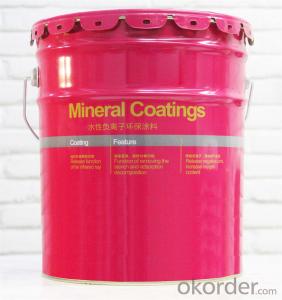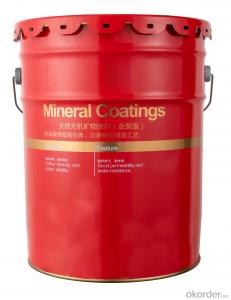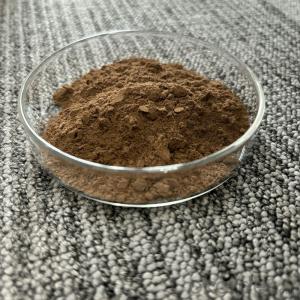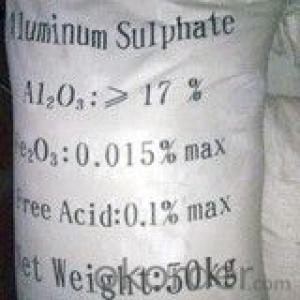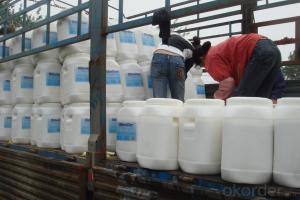Low-Iron Aluminum Sulfate First Grade China Supplier
- Loading Port:
- Qingdao
- Payment Terms:
- TT OR LC
- Min Order Qty:
- 25 m.t.
- Supply Capability:
- 12000 m.t./month
OKorder Service Pledge
OKorder Financial Service
You Might Also Like
1. Chemical and Physical Properties:
Product name: Aluminium Sulphate or Aluminum Sulfate
Shape: Flakes or Granular or Powder.
EINECS NO.:233-135-0
CAS No.: 10043-01-3
HS.Code: 28332200
Molecular Formula: Al2(SO4)3
Appearance:It is white or grey flake,particle or massive crystallization.
Apt to cake after moisture absorption when laid in air for a long time.A little green because of Fe2+ ,yellow when Fe2+ is oxided to Fe3+.Soluble in water easily,and water solution is acid.
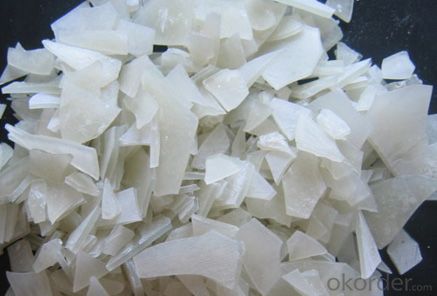
2. Specification:
Standard: HG/T 2225-2001 and HG/T 2227-2004
Items | Specifications | |||
I Type:Low Ferrous/Low Iron | II Type:Non-Ferrous/Iron-free | |||
First Class | Qualified | First Class | Qualified | |
Al2O3 % ≥ | 15.8 | 15.6 | 17 | 16 |
Ferrous(Fe )% ≤ | 0.5 | 0.7 | 0.005 | 0.01 |
Water Insolube % ≤ | 0.1 | 0.15 | 0.1 | 0.15 |
PH (1% aqueous solution) ≥ | 3.0 | 3.0 | 3.0 | 3.0 |
Arsenic(As) %≤ | 0.0005 | 0.0005 | ||
Heavy metal (Pb) %≤ | 0.002 | 0.002 | ||
3.Applications:
Water effluent treatment system
It's used for purification of drinking water and wastewater treatment by settling of impurities by
means of precipitation and flocculation.
Paper Industry
It helps in sizing of paper at neutral and alkaline pH, thus improving paper quality (reducing spots
and holes and improving sheet formation and strength) and sizing efficiency.
Textile Industry
It is used for color fixing in Naphthol based dyes for cotton fabric.
Other Uses
Leather tanning, lubricating compositions, fire retardants; decolorizing agent in petroleum, deodorizer; food additive; firming agent; dyeing mordant; foaming agent in firefighting foams; fireproofing cloth; catalyst; pH control; waterproofing concrete; aluminum compounds, zeolites etc.
4. Package:
Packaging Detail: PP/PE 50kg/bag;25kg/bag;Jumbo bag or according to customers' requirements.
20-25MT will be loaded in per 20'FCL container.
5. Attention and Storage:
The product is liable to absorb moisture and clot due to long-term exposure, so shady, cool and ventilated environment is needed.
Usage:
For the manufacturing of wood –pulp,paper,alum,aluminium salt, printing ink,lubricant,boiler cleaning agent,satin white,oilcloth,linoleum,ceramics,for sizing paper,clarifying fats and oils,tanning white leather,and water purification as deodorization and decolourizer in petroleum refining,as filtering medium water-proofing agent,and as mordant in dyeing.
FOB Port: China main port
Minimum Order Quantity: 25MT
Supply Ability: 4000MT/Month
Payment Terms: L/C or TT
Delivery Time: 7-10 days
- Q:I know that a species that does not appear in the chemical equation may also affect the rate of a reaction - e.g. a catalyst. But does that mean the catalyst can be present in the rate equation, and if so are catalysts always present in the rate equation?
- Yes, a catalyst can be included in a rate law. That's because, most reactions occur in a series of step and the rate is based on the rate determining step, which is the slowest step. A catalyst may be a reactant in the rate determining step, and a product in a subsequent step. Therefore, the catalyst is not included in the overall reaction. But a catalyst need not always be in the rate law. The rate law is usually based on the rate determining step. ========== Follow up =========== In the free response questions on the AP chemistry exam there has been at least one case where a rate law included a catalyst( 2002D). Brown and LeMay always include at least one in their examples, and I always cover this situation when I teach rate laws and mechanisms in AP chemistry. Here is one comment: Other examples of species not in the balanced reaction occurring in the rate law would include catalysis, where a catalyst does not normally appear in the balanced reaction but does appear in the rate law. www.chem.arizona.edu/~salzmanr/48... Consider this generalized reaction which is catalyzed by M A + B --C A + M --Q ... slow Q + B --C ... fast M is the catalyst, and Q is the intermediate. The slow, or rate determining step, depends only on the concentrations of A and M, the catalyst. So even though the overall reaction does not include, M, the rate law does. Rate = k[A][M]
- Q:Is the reaction of the exhaust purification of cars (carbon monoxide and nitrogen
- Can not react
- Q:What is the definition and function of the catalyst in chemistry?
- The catalyst plays an important role in chemical production. For example: in the oil refining process, the use of high-performance catalyst into gasoline and no other; in the car exhaust treatment process, with the catalyst to promote harmful gas conversion ...
- Q:What is the principle of the catalyst? Why can change the rate of chemical reactions and their own without any change
- The catalyst is a substance that alters the reaction rate without changing the total standard Gibbs free energy of the reaction. The composition, chemical properties and quality of the catalyst itself do not change before and after the reaction; its relationship with the reaction system is as highly selective (or specific) as the relationship between the lock and the key. A catalyst does not catalyze all chemical reactions. For example, manganese dioxide catalyzes the thermal decomposition of potassium chlorate, accelerates the reaction rate, but does not necessarily have a catalytic effect on other chemical reactions. Some chemical reactions are not only the only catalyst, such as potassium chlorate can be thermally decomposed in the catalytic role of magnesium oxide, iron oxide and copper oxide, etc., potassium chlorate oxygen can also be used when the red brick powder or copper oxide as a catalyst.
- Q:What is the difference between biological enzymes and chemical catalysts?
- Biological enzymes are an environmentally friendly biocatalyst with greater superiority. Such as the reaction speed, processing conditions (such as temperature, PH value, etc.) more moderate, safe and easy to control the operation and can replace the strong alkali and other chemicals. The biological enzymes act only on specific substrates, with little damage to the substrate and the biodegradation of the treated wastewater to reduce water and energy consumption. After more than a century of research by scientists, more than 3,000 known enzymes are generally considered. The application of biological enzymes in the textile industry, initially the application of α-amylase in cotton fabric desizing process, and later developed into the cellulase used in denim washing and bio-polishing process, and now the development of pectinase to the biological scouring Technology, hydrogen peroxide enzyme catalytic decomposition technology, protease in silk and wool fiber applications
- Q:No one knows the expression of the catalyst and the chemical expression of the acridine
- In organic reactions, the catalyst is complex and consists of several or more. Write Chinese characters directly.
- Q:Exemplify the use of green catalysts in green chemistry
- Photocatalytic water generates oxygen and hydrogen
- Q:Which chemical reaction is added to the catalyst in order to slow down the reaction
- Edible oil added 0.01% to 0.02% gallate n-propyl ester, you can effectively prevent rancidity
- Q:What are the catalysts for making oxygen in chemistry? (At least 8 listed)
- Manganese dioxide, iron oxide (red brick powder), copper oxide, ferrous oxide, iron oxide, activated carbon, egg shell, fresh liver, raw potato chips, etc.
- Q:How do I write about the ion equation?
- 4NH3 + 5O2 == 4NO + 6H2O
1. Manufacturer Overview |
|
|---|---|
| Location | |
| Year Established | |
| Annual Output Value | |
| Main Markets | |
| Company Certifications | |
2. Manufacturer Certificates |
|
|---|---|
| a) Certification Name | |
| Range | |
| Reference | |
| Validity Period | |
3. Manufacturer Capability |
|
|---|---|
| a)Trade Capacity | |
| Nearest Port | |
| Export Percentage | |
| No.of Employees in Trade Department | |
| Language Spoken: | |
| b)Factory Information | |
| Factory Size: | |
| No. of Production Lines | |
| Contract Manufacturing | |
| Product Price Range | |
Send your message to us
Low-Iron Aluminum Sulfate First Grade China Supplier
- Loading Port:
- Qingdao
- Payment Terms:
- TT OR LC
- Min Order Qty:
- 25 m.t.
- Supply Capability:
- 12000 m.t./month
OKorder Service Pledge
OKorder Financial Service
Similar products
New products
Hot products
Related keywords
